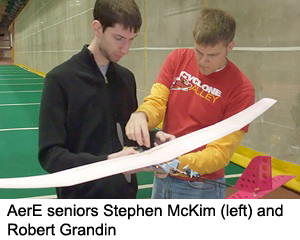Three teams of Iowa State University aerospace engineering students had a unique opportunity this fall when they participated in the Silent Stamina challenge, sponsored by Lockheed Martin, for their senior design capstone project. The project goal was to design and build a radio-controlled airplane that can fly quietly (75 decibels or less) in an indoor environment for a sustained length of time.
Lockheed Martin specified the battery size so the teams’ task was to figure out how to get maximum life out of the battery. That meant designing a plane that was very light and yet strong enough to support the battery’s weight. In addition, they had to come up with creative ways to reduce noise created by the motor and propellers.
The project provided a great learning opportunity, according to course instructor Steve Holland. “In the classroom we do all sorts of analysis and come up with paper designs that in theory might work, but you can never predict everything,” Holland says. “As the teams built and tested their planes, they found that some things didn’t work the way they expected. It was a dose of reality for them. As engineers you have to have a feel for all of the different ways something might fail so you can determine exactly how strong each part needs to be.”
Lockheed Martin sponsors the challenge to help students gain that first-hand experience. “The students work in a small group, much like we do here,” explains Matthew Orris, a systems engineer at Lockheed Martin in Minneapolis and a 2006 aerospace engineering graduate from Iowa State. “This project gives them a little experience doing a lot of different tasks from the nuts and bolts of engineering to program management to actually building and testing an airplane. And it culminates in something fun—the competition.”
Orris, who had served on several Iowa State senior design review panels, was instrumental in Lockheed Martin extending an invitation to Iowa State to participate in Silent Stamina. He served as a resource throughout the semester as the students developed their designs and built their planes. That contact, he notes, helps Lockheed Martin build a talent pipeline for future employees.
The Silent Stamina competition took place on December 8 with 10 teams competing—three from Iowa State, two from the University of Minnesota, three from a Minneapolis RC club, one from Lockheed Martin, and one from Portugal. Due to a blizzard that struck the Midwest that day, the Iowa State teams—Silent Sasquatch, Slyclones, and Silent Cyclones—flew their planes at the Lied Recreation Center on campus while the other teams flew at the Hubert H. Humphrey Metrodome in Minneapolis.
Silent Sasquatch finished first among the three Iowa State teams with nearly 31 minutes of flight time and 50 bonus minutes added for achieving a noise level of only 65 decibels, 10 below the maximum. When the bonus and penalty points for all of the teams were tallied, a team from a Minneapolis RC club won the competition and Silent Sasquatch placed third.
The students say the opportunity has been an invaluable experience. “It was great to be able to start from a blank piece of paper and design and build the actual plane and test it,” says Dan Zimmerman, a member of the Slyclones, which had a flight time of 38:15 minutes and earned 40 bonus minutes for a noise level of 67 decibels. “We had to be able to handle multiple engineering disciplines at once and consider how decisions we made in each of the subsystems—for example electrical, or power train, or aerodynamics—affected the system as a whole.”
Brett Barnes, a member of Silent Sasquatch, says his team quickly learned to plan for the unexpected when a wing failed. “We had assumed,” he explains, “that the building materials were perfect, but soon discovered the blue foam from which we had cut the wing varied in density, causing different parts of the wing to flex differently.” As a result the team had to return to the drawing board to find a better solution.
Molly White’s team, the Silent Cyclones, completely rebuilt the fuselage just a week before the competition. They had discovered they had too much vibration and needed to start over again. “It was rewarding to realize that we weren’t afraid to revamp our design and try something new and different,” she says. The Silent Cyclones flight time was 6:59 and the team earned 30 bonus minutes for a noise level of 69 decibels.
The best part of the competition, according to Stephen McKim, a member of Silent Sasquatch, was seeing the different approaches the teams took. “We were all using the same equations and the same design principles,” he says, “but each team approached the individual parts of the problem differently and that’s what made the project really cool.”
